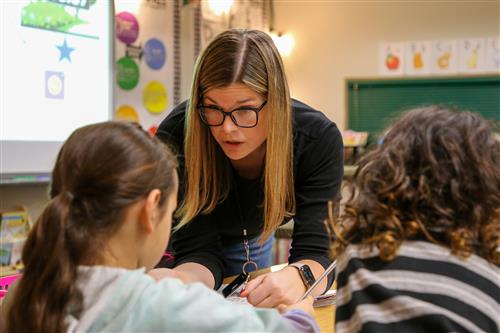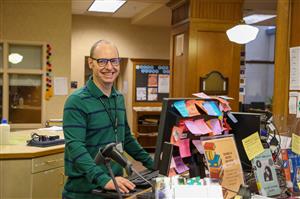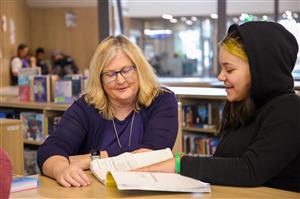- Spokane Public Schools
- More SPS Stories
School libraries: How the space, and use, has changed
Posted by Ryan Lancaster on 4/9/2024

If you haven’t visited a school library in a while, you may picture a quiet home for dusty tomes, overseen by a shushing librarian and their well-ordered card catalog.
But the spaces – and the people who manage them – have evolved to be more open and engaging, offering access to 21st century technology and a range of learning for every age group.
They can even be – gasp – noisy.
“We let students eat and be loud in the library,” said Lewis & Clark High School Library Information Specialist (LIS), Mark Robbins. “We host a lot of after-school clubs. And it feels more like a coffee shop than a computer lab, which is what it felt like to me before.”
Students now bring their own laptops, and when Mark and fellow LIS Eric Woodard aren’t busy troubleshooting tech, they’re working to brand the library as a safe, comfortable place for all. The shelves are filled with locally purchased books co-curated by students and staff at the school. There's chess, a well-attended Nintendo and Dungeons & Dragons club, even sewing machines available for checkout.

Thanks to more efficient systems, the process of checking out actual books takes up relatively little time, although Mark said he enjoys connecting with students over what they’re reading. He also coordinates with staff and teachers to promote literacy and finds resources to support what’s being taught in class.
“We want the library to be an extension of every classroom,” Mark said.
New space, new name
Instead of a library, the recently built Flett Middle School has a “learning commons,” which has few walls and is located at the heart of the building. It’s a busy place, where students are encouraged to work and create together.
LIS Michelle Meek said the space and furniture are designed to facilitate collaboration while still allowing students to find quiet when needed. Like her high school counterparts, she does much more than process book borrowing.
“We teach students how to use the self-check and Spokane Public Library resources so they have access to books anytime, which frees us to help students and teachers in other ways,” Michelle said.

Most of that time is spent guiding students to be better learners by becoming adept at accessing information for research or personal interest, managing and using technology, growing into critical thinkers. "Sometimes we just provide a space and tools for them to take a break from the world,” she said. “What I love most about my job is that I get to connect with so many people for different purposes.”
Beyond storytime
A common misconception Katie Anderson hears about her job as Cooper Elementary School’s LIS is that it’s all about coloring, playing, and reading books with students.
“There are of course times those things happen, but the 45 minutes we get each week with students are all used intentionally,” she said. “Our instruction must align with American Association of School Librarian standards that correlate to the report card. We give grades based not only on observational data, but multiple assessment data points as well, just like their classroom teachers.”
Her students learn how to type, code, conduct ethical research, understand digital etiquette and safety, work with peers and much more. She collaborates with teachers to create interdisciplinary connections, helps students find great books and authors, and – yes – occasionally reads aloud to a group of rapt little people sitting crisscross applesauce.
“What I love most is getting to teach all the students every year and getting to know them all so well,” Katie said. “I get to witness their growth and build on each skill or process as they move towards middle school.”
All this happens in one moderately sized, very engaging space. Each square foot of the elementary library has a purpose, from Maker Spaces and story stairs to an interactive flat panel for students to manipulate. One area houses an audio book station for young readers while another hosts a KSPS PBS cart with iPads for classroom teacher checkout. There are book displays to pique student interest and curated bins of books based on each heritage month.
Katie sums it up: “The library is no longer a just a computer lab with books; it's become much more encompassing than that.”
Recent
By Month
- April 2024
- March 2024
- February 2024
- January 2024
- November 2023
- October 2023
- September 2023
- August 2023
- July 2023
- June 2023
- May 2023
- April 2023
- March 2023
- February 2023
- January 2023
- December 2022
- November 2022
- October 2022
- September 2022
- August 2022
- July 2022
- June 2022
- May 2022
- April 2022
- March 2022
- February 2022
- January 2022
- December 2021
- November 2021
- October 2021
- September 2021
- August 2021
- July 2021
- June 2021
- May 2021
- April 2021
- March 2021
- February 2021
- December 2020
- November 2020
- October 2020
- March 2020
- November 2019
- October 2019
- May 2019
- April 2019
- February 2019
- January 2019
- November 2018
- October 2018
- September 2018

